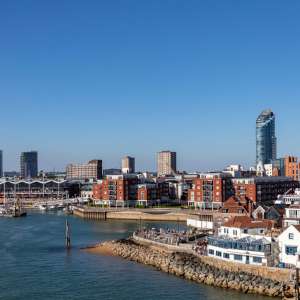Shipping from London to Hong Kong: Cost-Effective Solutions
Latest update on 18 July, 2024 by Caspian Ng– Marketing Analyst at FreightAmigo
Navigating the complexities of international shipping, especially when it involves shipping from London to Hong Kong, demands a meticulous understanding of logistics, including the choice between air freight and sea freight, customs clearance processes, and the nuances of packing services. The significance of this trade route can hardly be overstated, given the busy exchange of goods it facilitates between two major global financial hubs. Therefore, finding cost-effective and efficient solutions for shipping container contents, whether for personal or commercial purposes, is paramount. This article aims to shed light on the most effective strategies to minimize shipping costs while ensuring the safe and timely arrival of goods.
As we delve into the intricacies of shipping to Hong Kong, this article will explore various aspects crucial for senders, including understanding the different shipping methods available and how to choose the best option, adhering to packaging guidelines to protect your shipment, and navigating customs clearance to avoid delays. Furthermore, readers will gain insights into maximizing cost-effectiveness through strategic planning and avoiding common pitfalls such as prohibited items and unexpected fees. Through a comprehensive guide, shippers can look forward to streamlining their shipping processes, making informed decisions on whether to opt for air freight or sea freight, and understanding door-to-door shipping options to ensure their cargo reaches its destination efficiently and economically.
Want To Compare The Best Express, Air Freight, Sea Freight, Rail Freight & Trucking Rates So As To Have Better Control On Cost?
Understanding Shipping Methods
When choosing the best method to ship goods from London to Hong Kong, businesses and individuals must consider factors such as speed, cost, and the nature of the goods being shipped. Here, we explore the primary shipping methods: sea freight, air freight, and courier services.
Sea Freight
Sea freight, also known as ocean freight, is the transportation of goods by ship and is especially cost-effective for large or heavy shipments. It is known for its economic efficiency and environmental friendliness compared to other shipping methods. Sea freight can be broken down into two main types: Full Container Load (FCL) and Less than Container Load (LCL). FCL is ideal for high volume shipments as it allows a single shipper to use an entire container, which can be more cost-effective and quicker than LCL, where goods must be consolidated with other shipments. However, sea freight generally has longer transit times, which can be a drawback for time-sensitive shipments.
Air Freight
Air freight refers to the transportation of goods by aircraft, which is faster than sea freight and is best suited for urgent or high-value shipments. While air freight offers rapid transit times and high reliability, it is typically more expensive than sea freight, making it less suitable for very large or heavy shipments unless speed is a critical factor. Air freight’s cost may also increase significantly with the weight and volume of the shipment, making it crucial to analyze the cost-benefit ratio for each specific situation.
Courier Services
International courier services provide a vital solution for shipping goods internationally, especially when dealing with smaller, time-sensitive shipments. These services offer expedited shipping options to ensure goods arrive quickly and are particularly useful for documents, small packages, or valuable items that require careful handling. Courier services often include door-to-door delivery, real-time tracking, and enhanced security measures, providing a comprehensive solution for urgent international shipping needs.
Each shipping method has its own set of advantages and considerations. For instance, while sea freight may take longer, it significantly reduces costs and carbon footprint, making it a preferred option for non-urgent shipments. On the other hand, air freight provides a quicker solution but at a higher cost and environmental impact. Finally, courier services offer the fastest, most secure shipping method for small to medium-sized packages.
Choosing the right shipping method depends on several factors including the nature of the goods, the required speed of delivery, budget constraints, and environmental considerations. By understanding the characteristics and benefits of each shipping method, shippers can make informed decisions that best suit their specific needs.
Packaging Guidelines
When shipping from London to Hong Kong, ensuring your goods are properly packaged is crucial for their safe and efficient transit. This section provides detailed guidelines on the materials and documentation you need to prepare for a hassle-free shipment.
Packing Materials
Choosing the right packing materials is essential for protecting your items during the long journey. For optimal protection, use double-walled cartons which offer extra strength and durability. These are specifically designed to withstand the rigors of international shipping and are less likely to squash or split compared to cheaper alternatives. Include plenty of bubble wrap for cushioning and secure all packages with strong packing tape. For delicate items like TVs and computers, it is advisable to use their original packaging if available. Additionally, for extra fragile items, consider using custom-built wooden cases or blanket wraps, which, although an additional cost, provide significant protection during transit.
Labeling and Documentation
Proper labeling and accurate documentation are key to ensuring your shipment clears customs smoothly and reaches its destination without delays. All packages should have clear labels with the following information in both English and Chinese: name of the food, list of ingredients, nutritional information, and any special storage instructions. This is particularly important for items like pharmaceuticals and food products, which have strict labeling requirements under Hong Kong’s regulations.
For non-food items, ensure that each box is labeled with the name and address of the manufacturer or packer, the count, weight, or volume of the contents, and any applicable use-by or best-before dates. Stick-on product labels are permitted to address any non-compliance issues, provided they are approved by the manufacturer and are in both English and Chinese.
In addition to labeling, prepare the necessary customs documentation, which includes manifests, import licenses, and an import declaration that must be filed electronically within 14 days of importation. Ensure all details on the declaration are accurate to avoid penalties. Depending on the nature of the goods, additional supporting documents like invoices or packing lists may also be required.
By adhering to these packaging guidelines and ensuring all documentation is in order, shippers can minimize potential disruptions and ensure their goods arrive in Hong Kong in excellent condition.
Cost-Effective Tips
Choosing the Right Shipping Method
When shipping from London to Hong, the choice of shipping method significantly impacts costs. For high-volume shipments, Full Container Load (FCL) offers a flat rate, making it more cost-effective when the container is fully utilized. Conversely, Less than Container Load (LCL) is suitable for smaller shipments that do not fill an entire container. Although LCL may be more accessible for lower volume shipments, it generally incurs higher costs per unit and longer transit times due to the need for consolidation and deconsolidation. Air freight, while faster, commands a higher price, making it ideal for urgent or high-value shipments. Each method has its trade-offs between cost, speed, and volume, and the choice should align with the specific needs of the shipment.
Consolidating Shipments
Consolidating shipments can lead to substantial savings, especially for importers dealing with multiple suppliers. By combining goods from several suppliers into one shipment, shippers can reduce the number of shipments and, consequently, the shipping costs. This process, known as buyer’s consolidation, allows importers to enjoy the economies of scale of FCL shipping without needing to fill an entire container with goods from a single supplier. For example, consolidating goods into one shipment can cost significantly less in sea freight charges, plus applicable UK Duty and VAT, compared to shipping items separately. However, it is crucial to consider the logistics of consolidation, including the proximity of suppliers and the additional local charges that may accrate from gathering goods at the consolidation point.
Customs and Regulations
Navigating the customs and regulations for shipping from London to Hong Kong requires meticulous attention to ensure compliance and avoid delays. This section outlines the essential documentation and highlights restrictions on certain items, providing shippers with the knowledge needed to facilitate smooth customs clearance.
Required Documentation
To import goods into Hong Kong, shippers must prepare and submit a variety of documents that are crucial for customs clearance:
- Manifestsand Import Licences or removal permits, if applicable, are mandatory.
- Detention Noticesshould be provided if the goods have been detained for any reason.
- Supporting Documentssuch as invoices, packing lists, and airway bills must accompany the shipment.
- An Import Declarationmust be lodged electronically within 14 days of importation through providers like Global e-Trading Services Limited, Tradelink Electronic Commerce Limited, or Brio Electronic Commerce Limited. Failure to submit this declaration on time can result in a penalty of up to HK$200.
- Depending on the goods, a Declaration Chargemay apply, ranging from HK$0.20 to HK$200.
For specific goods like pharmaceuticals and food products, labels should include detailed information in both English and Chinese, and health certificates may be required to certify that the food is fit for consumption.
Restricted Items
Hong Kong maintains strict controls on certain items to ensure safety and compliance with international standards:
- Prohibited Articles: Without the appropriate licences, permits, or certificates, importing prohibited items such as endangered species, certain chemicals, and firearms can lead to severe penalties.
- Controlled Substances: Importing goods like radioactive materials, hazardous chemicals, and radio equipment requires special permits from relevant Hong Kong authorities.
- Animal and Plant Regulations: The importation of animals, plants, or related products is heavily regulated and generally requires a permit issued by the Agriculture, Fisheries and Conservation Department.
- Strategic Commodities: Items that could be used in weapons proliferation are closely monitored under the Import and Export Ordinance, Cap. 60, with strict licensing requirements.
Shippers should also be aware that while Hong Kong does not impose customs fees or VAT on most goods, duties are applicable to specific commodities like liquor and tobacco under the Dutiable Commodities Ordinance.
Conclusion
Throughout this discussion on the intricate process of shipping from London to Hong Kong, we have delved into the myriad aspects that make international logistics both challenging and rewarding. From selecting the optimal shipping method—be it sea freight, air freight, or courier services—to understanding the crucial importance of correct packaging and navigating customs regulations, the ultimate goal has been to illuminate paths toward cost-effective and efficient shipping solutions. The benefits of such strategic logistics planning are clear: not only can shippers save on costs and minimize delays, but they can also ensure their goods move seamlessly across global pathways, bridging the distance between two pivotal economic hubs.
As we conclude, it’s imperative for businesses and individuals alike, looking to navigate the complex terrain of international shipping, to seek out expert advice and tailored solutions that align with their specific needs. FreightAmigo stands as a guiding beacon in this regard, offering a wealth of knowledge, bespoke solutions, and an intuitive platform that simplifies logistics management. For a deeper dive into optimizing your shipping strategy from London to Hong Kong and to explore personalized options that cater precisely to your needs, we encourage you to visit the FreightAmigo website. Here, you will find the tools and expertise to ensure your goods not only reach their destination safely and on time but do so in a manner that aligns with your logistical and financial objectives.
If You’re Looking To Ship From London to Hong Kong, Please Go To The FreightAmigo Page For Inquiries.
Read more:
Shipping to Hong Kong from US
Shipping from China to Hong Kong
Ship From Hong Kong to United States
If you have any inquiries on logistics / supply chain, feel free to contact FreightAmigo now:
Chat with us online | Hotline: +852 28121686 | WhatsApp: +852 27467829










































